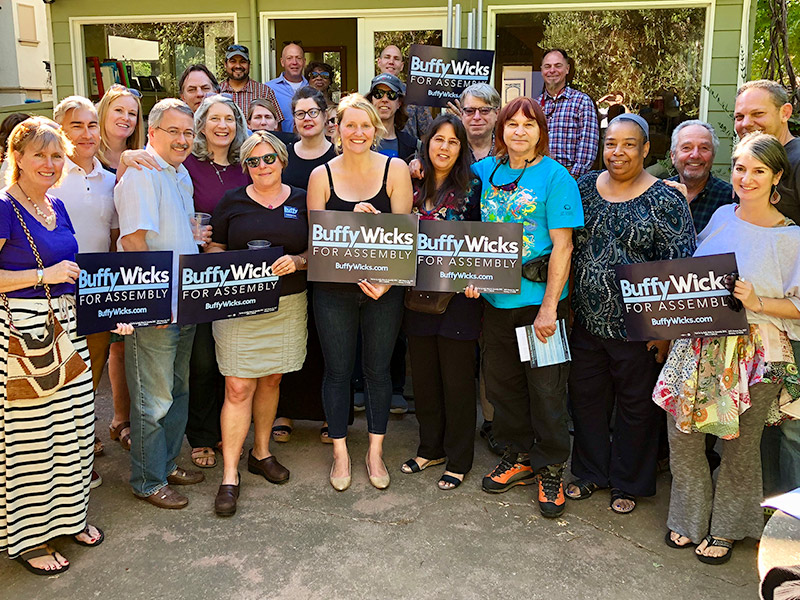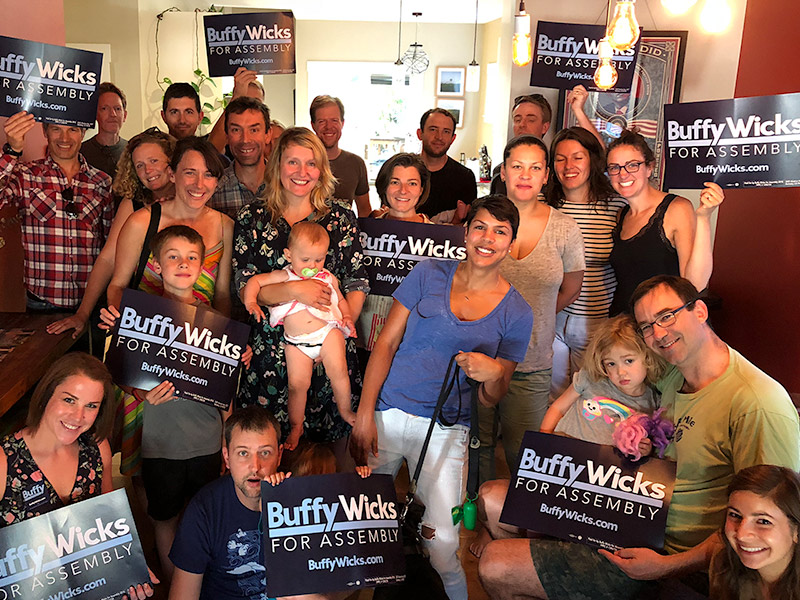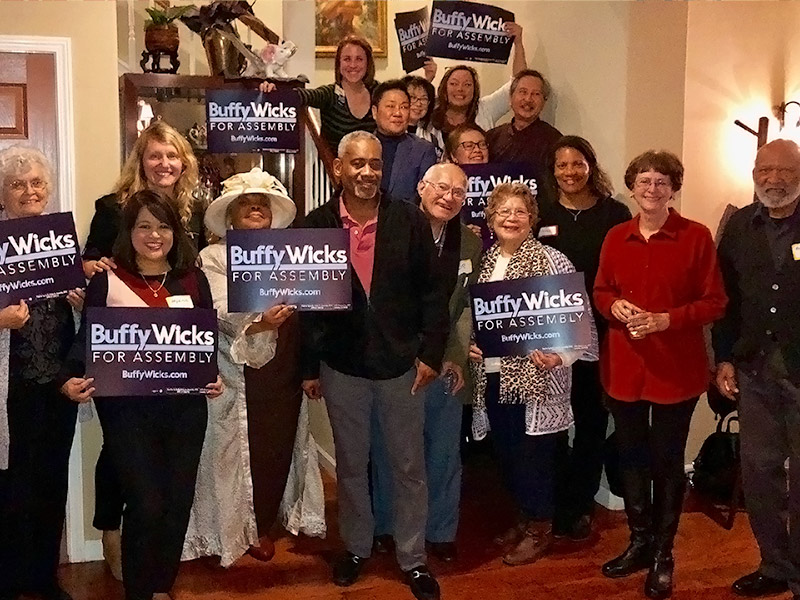



Safe and Just Communities
Californians pride ourselves on our progressive policies. We’re proud of our values of diversity, equality and equity. We’ve made great strides towards improving our broken criminal justice system. We’ve reformed drug policies that targeted low income black and brown communities, overwhelmingly passed Prop 57 to emphasize rehabilitation over retribution, and severely limited abusive solitary confinement for juveniles.
But we still have a lot of work to do. Prison overcrowding is rampant, with many facilities operating at nearly 150% of design capacity. Over 60% of inmates return to prison within three years of being released. Our broken bail system incarcerates people simply for being poor. Women’s incarceration has increased 700% since 1980.
Our justice system is far from equal; we can’t talk about criminal justice reform without talking about its racial disparities. People of color are disproportionately targeted for arrest, face harsher sentencing, and are less likely to receive parole. One in seventeen white men will face incarceration in their lifetime, but for black men that number is a shocking one in three.
Justice demands a more holistic approach to dealing with crime, one which looks at crime’s root causes and seeks to address these issues at their foundations. Many law enforcement leaders themselves understand that we cannot simply arrest and incarcerate our way to safety: we must ask difficult questions and discern the underlying causes of crime so we may reinvest in our communities to address those causes. This will mean investing in community-based approaches that ensure everyone has access to preventative health care and mental health care, quality education, job training, trauma recovery and affordable housing. Crime is a symptom of these disparities; it cannot be solved until its causes are addressed.
What can California do? Here is a starting point:
Reform Starts in the Classroom
California’s prison costs have steadily risen in tandem with California’s falling education spending. In the last 30 years, we’ve built 22 new prisons but only one new University of California campus. On average, we spend annually less than $10,000 per pupil for K-12 education, and over $70,000 per prisoner. The solution is to reinvigorate education both for our children and for those involved in the justice system.
The classroom is where we teach California’s future leaders what good citizenship and good governance looks like. We must make good on the vision of California as a state of opportunity by teaching students from day one that they can learn from their mistakes instead of being held back by them.
We must end the school to prison pipeline. This means reducing police presence on school campuses by investing in school counselors, nurses and teachers, decreasing suspensions and expulsions that disproportionately target children of color, and prioritizing restorative justice over zero tolerance policies.
We must also build a prison to school pipeline. This means we need to fund vocational and academic education for incarcerated individuals, support second chance programs, and strengthen programs like Project Rebound and the Underground Scholars Initiatives — programs at higher education institutions, including UC Berkeley and East Bay community colleges and CSU’s that empower formerly incarcerated individuals to receive college degrees.
The classroom should not be a doorway to incarceration, and a past conviction shouldn’t be a life sentence to poverty and joblessness. We need to seriously invest in second chances, revitalize compassion and increase educational funding to meaningfully combat these critical barriers to safety and prosperity.
Redirecting Young Lives Instead of Incarcerating Them
There are about 6,000 young people currently incarcerated in the state, costing about $1 billion a year. Three out of four are incarcerated for non-violent behavior and 57% haven’t been convicted of a crime. These young people are disproportionally people of color (80% African American or Latino). African Americas and Latinos are more likely to be incarcerated after arrest while white youth are more likely to be sent to diversion programs. Incarcerated youth are much more likely to have been victims of trauma and over half have mental health issues. Locking them up will not address these underlying issues and will certainly not make our communities safer.
We must hold our young people accountable for crimes committed but incarceration is not the answer – it is the least effective, most expensive and most harmful approach. Instead we should support community-based services, which produce better outcomes for youth and reduce recidivism. We should support restorative justice programs like Restorative Justice for Oakland Youth and preventative programs like RYSE in Richmond. And we should promote individualized treatment enabling young people to have access to a diverse set of community-based options thereby allowing them to create a tailored treatment plan.
While holding people accountable for crimes committed, we should also strive to decrease recidivism and enable young people to make permanent exits from the revolving door of crime and incarceration. By build healthy communities, we will experience less crime.
Ending Money Bail and Fines and Fees
Our justice system must stop discriminating against the poor, who are predominately people of color, when it comes to court-ordered fines and fees. These cash requirements entrap people in a debilitating cycle of police stops, incarceration, judicial debt, and license suspension, which altogether create barriers to housing and employment, and makes us all less safe.
This is particularly evident in our broken money bail system. Money bail was a system created to guarantee that defendants would appear for trial. Instead, it puts a price on freedom that very few can afford.
Research from UCLA has found that the highest bail requirements are disproportionately imposed on black and brown defendants, whose communities often suffer the highest rates of unemployment. More than 70% of defendants studied could not meet their bail requirements, so they remained incarcerated waiting months or even years for their case to go to trial while wealthier defendants bought their freedom. Money bail ensures that an accused person’s right to go home is based on their socioeconomic status rather than their flight risk or the severity of their alleged crime.
We need to create a more effective and equitable system of pretrial release. New Jersey has already eliminated money bail, resulting in a reduction of the state’s jail population by 15.8%, while crime has simultaneously reduced by almost 4% and violent crime by 12.4%. In Sacramento, I plan to work with the Attorney General and my fellow legislators to sponsor bills to end money bail and other financially discriminatory court practices.
A Public Health Approach to Drug Policy
With the opioid crisis dominating national headlines, California has a responsibility as a pioneer of progress to set the standard for how this country approaches drug policy. We’ve made headway with the decriminalization of cannabis, but we need to start emphasizing rehabilitation over retribution across the board for drug use. We must address substance use disorders as public health problems rather than criminal justice issues.
This public health approach starts by eliminating stigma and discrimination towards individuals with substance abuse disorders. Those suffering from drug dependency sometimes commit crimes such as theft and battery in connection with their addiction. Punitive measures may satisfy someone’s desire for retribution, but they fail to address the root cause of the problem and they don’t actually make us safer. We need to approach drug-related crimes from an understanding of addiction as a neurological disease and symptom of environmental pressures.
We can better address drug crime and dependency by prioritizing drug treatment over punitive prison sentences, and by expanding innovative, harm-reduction approaches that help addicts on their road to recovery. We also need to support drug-related research to create evidence-based rehabilitation programming, particularly for chronic users. For patients of treatment programs, we need to ensure access to scheduled medications, such as buprenorphine, for therapeutic use.
A public health model will help mitigate prison overcrowding and reduce excess corrections expenditures. We need to transform the way we think about and legislate drug ‘crime’ to create a system built on empathy and pragmatic solutions rather than ineffective punitive approaches.
A Public Health Approach to Homelessness
It’s no secret that California is currently suffering from a dual crisis of scarce affordable housing and unprecedented levels of homelessness. Part of the solution to this crisis is building more affordable housing, as well as more housing at all income levels. But we cannot begin to address this crisis without having a conversation about how we can better care for our growing population of homeless individuals.
All too often, California tries to incarcerate its way out of homelessness. The National Institute of Health found that approximately 15% of incarcerated individuals had dealt with an episode of homeless in the year prior to their incarceration. Homelessness often involves a vicious mental illness cycle: those who lack mental healthcare services are more likely to become homeless, and homelessness often causes serious mental illness. A person dealing with severe mental illness in California is four times more likely to be in prison than in a state mental healthcare facility.
We need to create a public health approach to homelessness. This approach begins by eliminating stigma against homeless individuals and recognizing that they are human beings deserving of attention and care. I support Gavin Newsom’s proposal to create a “homelessness czar” in Sacramento, a state secretary who will be specifically focused on ameliorating the crisis of homelessness.
Instead of arresting homeless individuals, we need to provide them with permanent supportive housing and clinical care. These services must include mental healthcare, counseling for substance use disorders, and job training. When formerly homeless individuals are released from incarceration, these services must be available and accessible to prevent the continuing cycle of homeless arrests. We also need to expand the use of behavioral health courts that hold people accountable for harms they committeed but steer people struggling with mential illness out of the criminal justice system and into treatment and support services.
Eliminating the Death Penalty
I don’t believe in the death penalty, full stop. The death penalty does not deter crime, is racially biased and may result in the execution of innocent lives. There is a disproportionate application of the death penalty to people of color. Even when people are properly convicted of a crime, people of color are more likely to get harsher sentencing, including the death penalty.
Since the death penalty was reinstated in 1978, California has spent an average of $308 million dollars on each of the 13 executions carried out. The death penalty is too high a price to pay for the possibility of wrongful execution. In Sacramento, I will help lead the push to end the death penalty in California.
Eliminating Solitary Confinement
Solitary confinement is the practice of isolating people in closed cells for 23 hours a day. It leaves individuals almost completely devoid of human contact for periods of time ranging from days to decades. Placing people in solitary confinement has often been used as an unjust preventative measure to manage anyone with a suspected affiliation to gangs. It also been used to quell political activism in prisons.
Solitary confinement imposes unjust psychological and emotional trauma on incarcerated individuals, especially those with pre-existing mental health issues. California has already begun the process of phasing out indefinite solitary confinement—the population of those in solitary confinement has decreased more than 60% since 2012. But we have to do more than simply reduce the numbers. We need to end the practice of solitary confinement as a whole to protect the basic human rights and dignity of incarcerated individuals.
Reforming and Informing Our Police Force
Following the tragic and preventable deaths of many black individuals—Trayvon Martin, Sandra Bland, Michael Brown, Philando Castile, Stephon Clark, and countless more—police forces have faced warranted increased scrutiny. Now is precisely the time to reform police practices to end systematic police brutality that disproportionately affects black and brown individuals and to build trust between police and the communities they are sworn to protect and serve.
The first step to accomplish this requires reforming the police bill of rights. State Senator Nancy Skinner has introduced a bill that would require the disclosure of investigations of serious uses of force, including police shootings. In Sacramento, I want to expand this by creating a mechanism for state-funded, independent investigations for all police officer involved shootings. This will allow local agencies to bring in outside investigators for use of force situations. In addition to a fair analysis of events, data collected through this process can help us develop policies to prevent future tragedy. We also need to expand the Racial and Identity Profiling Act of 2015 to include not just collecting data at the agency level, but at the officer level so problem actors can be identified early. We can’t reform police practice from a purely external standpoint. We also need to introduce systemic internal reforms and change the culture of policing from a warrior mentality to a guardian mentality.
We can begin to internally reform police practices by incorporating mandatory implicit bias, procedural justice, and de-escalation training into police academies and promote re-training throughout policing careers.
Throughout California, there is an immediate and serious deficit of police officers. When policing staff is low, police experience excess stress and demoralization, and police hiring practices necessarily become less stringent. We need to increase funds to hire diverse police officers from underrepresented backgrounds who are compassionate, capable, and well-trained, so that California’s police forces can lead the way for the rest of the country.
We need to work together to rebuild trust. Having a diverse and educated police force makes possible meaningful community policing, whereby police are no longer threats but integrated members of neighborhoods across California. Only through these measures can we begin to prevent incidents of police brutality and meaningfully move towards a compassionate policing system that protects and serves all of our communities.

Email us: hello@buffywicks.com
Buffy Wicks for Assembly 2024. FPPC #1456909
